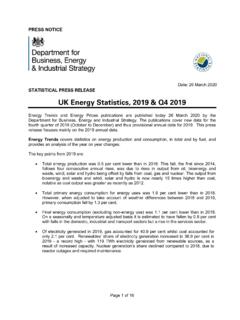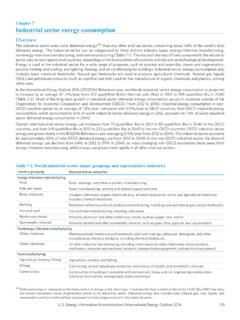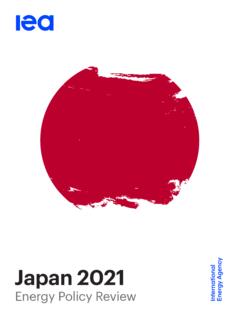Transcription of 2021 TotalEnergies Energy Outlook
1 TotalEnergiesEnergy Outlook 2021 September 2021 - TotalEnergies Energy Outlook2 MomentumA forward-looking scenarioAchievement of Paris agreement well-below 2 C target based on IPCC emissions scenarios*Assumes strong shifts in non NZ 2050 countries public policies, large scale cleantech advancements and rebuilding a new Energy systemat a global scaleRuptureA back-casting approachTemperature rising by C in 2100 Temperature increase limited to CBased upon decarbonization strategies of Net-Zero 2050 (NZ 2050) countries, with China on-track to achieve carbon neutrality by 2060 Announced targets & NDCs of other countrieswith a sensitivity for a C scenarioTotalEnergiesEnergy Outlook 2021 Two demand scenarios to 2050* Temperature ranges ascertained by comparing Energy -related CO2 emissions trajectories from the IPCC P66 scenarios.
2 What s new in our 2021 scenarios?September 2021 - TotalEnergies Energy Outlook3 Extension to all emerging economies of NZ 2050 countries decarbonization trendsAmplification of Energy transition levers allowed by innovation diffusion:-Increasedenergy efficiency-Further development of electricity & renewables-Higher penetrationof new Energy carriers (clean H2 in industry & transport, e-fuels, biofuels and )Ban on new ICE* sales in NZ 2050 countries in 2035 spurring a revolutionin transport:-Electrificationof light vehicles-Increased adoption of H2, H2-based fuels** and bioenergiesin other transport segmentsBroad end-use electrification with increasing demand for renewable power (solar & wind)Large scale use of natural gas as a transition fuel especially in power & industrySingle-use plastic ban in NZ 2050 countries & China from 2040 and increased plastics recyclingChina semissions to peak in the mid 2020 s, with ~60% decarbonization by 2050 Momentum: market trends acceleration & NZ 2050 countries commitmentsGDP growth: + growth: + : how to reach well-below 2 CGDP growth: + growth.
3 + * Internal Combustion Engine** IncludesH2, e-fuels (H2 + CO2), methanol, 0002 0001990200020102020203020402050400800 Meeting the Energy needs of a growing populationNecessity of a just transitionSeptember 2021 - TotalEnergies Energy Outlook4 World total Energy demand in MomentumPJ/d World population will grow from 8bn today to 10bn people by 2050, driven by non-OECD countries: + 2bn Growing population and improving living standards will increase Energy demand, again driven entirely by emerging countries The evolution of Energy demand per capita over the next 30 years is critical for non-OECD countries Without these countries the global Net-Zero goal cannot be achievedWorld Energy demand per capita in 2019MJ/d/capitaOECD( )Non-OECD(+ )World(+ )OECDW orldNon-OECD(CAGR* 2019/50)The challenge: reconciling growing Energy demand with decarbonization and broader sustainable development goals* Compounded Annual Growth RateHow to curb emissions?
4 A collective engagement, from suppliers to consumersSeptember 2021 - TotalEnergies Energy Outlook5 Global anthropogenic GHG emissions in 2018 GtCO2ePower&HeatTransportIndustryRes&Com Other*33 Gt CO2CO2 from non- Energy (industrial processes, land-use )Other greenhouse gases ( )Methane from agriculture, wasteMethane from the oil & gas industryMethane from coal, bioenergy* Energy sector own use, CO2 The climate challenge requires action on all greenhouse gases and the decarbonization of energyMore Energy & less emissionsEnergy transition pathwaySeptember 2021 - TotalEnergies Energy Outlook6 More Energy in all scenariosGreener liquids & gasesH2 increased penetration in industry and transportationOil plateaus before 2030 and declines thereafterGas enabler of the Energy transition in power & industryRadical electrification, with storage playing a key roleRenewables decarbonizing the power sectorCarbon sinks (CCS*, NBS**)
5 Key for the Net Zero journey* Carbon Capture & Storage **Nature-based solutionsEnergy efficiency Behavior Electrification Switch Coal/Oil-to-Gas Solar & Wind / Storage Biofuels / Biogas Hydrogen CCS Recycling / Re-use Key drivers for Energy transition in each sectorHow to decarbonizeSeptember 2021 - TotalEnergies Energy Outlook7 Residential & CommercialPowerDriverTransportIndustryIm pact level: Low Medium HighStrong electrification of end-use ~20% of final demand~30%~40%Deep decarbonization of power supply solar+wind: ~110 GW/yrcapacity additions since 2010 Pace (380 GW/yr)Pace x6(620 GW/yr)Gas going greener<1% green gases in gas supply~20%~30%Sustainable mobility< 1% BEV & FCEV* in light vehicles fleet~65%~80%~100% kerosene fueling aircraftsSust.
6 Aviation fuels @ ~30% of demandSAF @ ~60%Optimizing plastics demand7% recycled 40% recycledSUP** ban Net Zero countries & China in2040~50% recycledWorldwide SUP** ban in2040 CCS to abate remaining emissions~35 Mt ( CO2 emissions)3 Gt (~10%)7 Gt (~45%) Energy efficiency intensity improvement since 2000+ + modeling drivers of our scenariosSector-based assumptionsSeptember 2021 - TotalEnergies Energy Outlook8 Rupture 20502019* Battery-Electric Vehicles and Fuel-cell Electric Vehicles ** SUP: single-use plasticMomentum 2050 MomentumKey Energy transition levers: Electrification and Energy mix diversification in transport Increased penetration of clean H2 Massive growth in power demandMomentum wrap-upZoom on NZ 2050 countriesSeptember 2021 - TotalEnergies Energy Outlook9 Electrification in Light Vehicles2035 ICE sales ban in NZ 2050 countries to accelerate LV fleet electrificationSeptember 2021 - TotalEnergies Energy Outlook10 Light Duty Vehicles* final consumption (Momentum)PJ/d Aggressive assumptions on EV penetration, with 2035 ICE sales ban in NZ 2050 countries In NZ 2050 countries, 100% of fleet converted to electricity or fuel-cells by 2050 (vs.)
7 ~90% in China) Such development will require massive new infrastructures (charging points and power network)Light Vehicles fleet (Momentum)Billion LDV accounting for 47% of 2019 Transport CO2 emissions EV fleet accelerating after 2030, displacing oil Oil below 50% in 2050 * LDV = Light Vehicles (Passenger cars + Light Commercial Vehicles) + 2-3 wheelers** IncludesH2, e-fuels (H2 + CO2), methanol, **ElectricityBiofuels & biogasNatural gasOilElectricity+ Hydrogen50%100%Mix diversification in Heavy Duty VehiclesElectricity and hydrogen to allow for decarbonization of truckingSeptember 2021 -TotalEnergiesEnergy Outlook11 Heavy Duty Vehicles* final consumption (Momentum)PJ/d Rapid increase of battery electric share for urban and some medium/long haul trucks Progressive penetration of fuel-cells and e-fuels in trucking after 2035 for long haul tripsHDV zero emissions share in traffic in 2050(Momentum) HDV accounting for 28% of 2019 Transport CO2 emissions Fuel-cells, clean hydrogen-based fuels and bioenergiesare key to decarbonize HDV, together with electricity* HDV =Trucks + Buses + Coaches** IncludesH2, e-fuels (H2 + CO2), methanol, **ElectricityNatural gasBiofuelsBiogasOilLong Haul(~70% of HDV traffic)Urban vehicles(~30% of HDV traffic)
8 H2-based**Elec25502019203020502550201920 302050 Multiple decarbonization paths in Aviation & MarineBioenergiesand H2-based fuels to decarbonize these hard-to-abate sectorsSeptember 2021 - TotalEnergies Energy Outlook12 Aviation final consumption (Momentum)PJ/d Marine accounting for 10% of 2019 Transport CO2 emissions LNG, moving to bio-LNG, part of the transition pathway together with clean H2-based fuels (methanol, ammonia,..)Marine final consumption (Momentum)PJ/d Aviation accounting for 13% of 2019 Transport CO2 emissions To be decarbonized, aviation needs large scale low-carbon liquids (Sustainable Aviation Fuels*), as electricity will remain marginalH2-based**ElectricityBiofuelsLNG B iogas* Sustainable Aviation Fuels = biofuels + e-fuels** IncludesH2, e-fuels (H2 + CO2), methanol, **ElectricityBiofuelsOil1002002019203020 50 Increased penetration of clean hydrogenA new driver of electricity demandSeptember 2021 - TotalEnergies Energy Outlook13 Clean H2 balance (Momentum)
9 MtH2 H2 production through electrolysis significantly increases electricity demand Electricity for H2 and in Transport represent 1/4 of 2050 demand total power demand up by over next 30 yearsPower demand by sector (Momentum)TWh Transport & Industry are the main users of H2 (incl. e-fuels) in Momentum, driven by NZ 2050 countries:-Scaling up clean H2 takes time-By 2050, clean H2 accounts for 4x today s (grey) H2 production~1/3 Blue H2~7 500 TWh elecfor H2~2/3 Green H2 TransportIndustryPowerRes. & Com.~500 Bcmgasfor H2 Other~1 Gt CCS~300~30~030 00060 000201920302050 Elec for H2 Transport30 00060 0002019203020505 00010 000 Massive growth in power generationLed by solar & windSeptember 2021 - TotalEnergies Energy Outlook14 Power generation (Momentum)TWh Solar & wind capacities multiply by 10 in 30 years ~10-15% dedicated to green H2 production in 2050 (> today s solar & wind capacities) In addition, ~1500 GW of batteries are needed to ensure constant delivery of electricitySolar & Wind capacities (Momentum)
10 GW Generation more than doubles by 2050, with wind & solar representing ~85% of new generation Gas is the only fossil fuel to grow in absolute terms to manage intermittency of solar & wind and demand seasonality (base-load, firm power)of which for H2 productionOther non-carbon (nuclear, )OilSolar & WindCoalNatural gas2019203020505001 0002019203020505102000201020202030204020 50 Momentum: World total Final ConsumptionElectricity becomes the #1 source of end-user Energy in the early 2040sSeptember 2021 - TotalEnergies Energy Outlook15 total final consumptionPJ/dCO2 emissions by sectorGt Steady growth of end-use Energy demand by 2050 ( ) with a strong change of the Energy mix Fossil fuels share down from 2/3 to less than halfRes&ComIndustryTransport Transport, n 1 end-user emitting sector today, accounts for the bulk of CO2 abatements by 2050 Natural gasCoalBiomassBiogasElectricityBiofuelsH 2-based*HeatOther renewablesOil* IncludesH2, e-fuels (H2 + CO2), methanol, 5005 00020192030205050100201920302050 Momentum.














